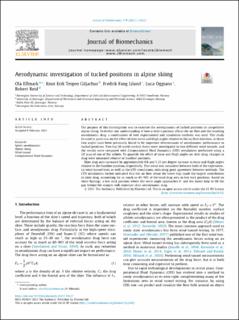| dc.contributor.author | Elfmark, Ola | |
| dc.contributor.author | Giljarhus, Knut Erik Teigen | |
| dc.contributor.author | Liland, Fredrik Fang | |
| dc.contributor.author | Oggiano, Luca | |
| dc.contributor.author | Reid, Robert | |
| dc.date.accessioned | 2021-04-22T11:19:12Z | |
| dc.date.available | 2021-04-22T11:19:12Z | |
| dc.date.created | 2021-03-03T09:45:00Z | |
| dc.date.issued | 2021 | |
| dc.identifier.citation | Journal of Biomechanics. 2021, 119, . | en_US |
| dc.identifier.issn | 0021-9290 | |
| dc.identifier.uri | https://hdl.handle.net/11250/2739117 | |
| dc.description.abstract | The purpose of this investigation was to examine the aerodynamics of tucked positions in competitive alpine skiing. To further our understanding of how a skier’s position affects the air flow and the resulting aerodynamic drag, a combination of both experimental and simulation methods was used. This study focused in particular on the effect of skier torso and thigh angles relative to the air flow direction, as these two angles have been previously found to be important determinants of aerodynamic performance in tucked positions. Two top 30 world-ranked skiers were investigated in two different wind tunnels, and the results were compared with Computational Fluid Dynamics (CFD) simulations performed using a 3D scan of one of the athlete. To quantify the effect of torso and thigh angles on skier drag, changes in drag were measured relative to baseline positions.
Skier drag area increased by approximately 0.8 and 1.2% per degree increase in torso and thigh angles relative to the baseline position, respectively. This trend was consistent between both of the experimental wind tunnel tests as well as the CFD simulations, indicating good agreement between methods. The CFD simulations further indicated that the air flow about the lower legs made the largest contribution to skier drag, accounting for as much as 40–50% of the total drag area in low tuck positions. Based on these findings, a low tuck position where the torso angle approaches 0° and the knees help to fill the gap behind the armpits will minimize skier aerodynamic drag. | en_US |
| dc.language.iso | eng | en_US |
| dc.publisher | Elsevier Science | en_US |
| dc.rights | Navngivelse 4.0 Internasjonal | * |
| dc.rights.uri | http://creativecommons.org/licenses/by/4.0/deed.no | * |
| dc.title | Aerodynamic Investigation of Tucked Positions in Alpine Skiing | en_US |
| dc.type | Peer reviewed | en_US |
| dc.type | Journal article | en_US |
| dc.description.version | publishedVersion | en_US |
| dc.source.volume | 119 | en_US |
| dc.source.journal | Journal of Biomechanics | en_US |
| dc.identifier.doi | 10.1016/j.jbiomech.2021.110327 | |
| dc.identifier.cristin | 1895157 | |
| dc.description.localcode | This is an open access article distributed under the terms of the Creative Commons CC-BY license, which permits unrestricted use, distribution, and reproduction in any medium, provided the original work is properly cited. | en_US |
| dc.source.articlenumber | 110327 | en_US |
| cristin.ispublished | true | |
| cristin.fulltext | original | |
| cristin.qualitycode | 2 | |

